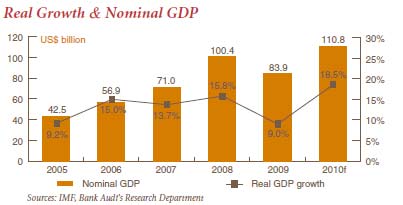Qatar Economic Report
Qatar’s economy is delivering an impressive buoyant performance in the midst of sluggish global conditions. According to IMF forecasts for 2010, real GDP growth is projected at 18.5%.
 Qatar’s economy is delivering an impressive buoyant performance in the midst of sluggish global conditions. According to IMF forecasts for 2010, real GDP growth is projected at 18.5%, the highest worldwide, after a 9% growth in 2009 and close to 15% average growth over the previous three years. Qatar has been significantly resilient to the global crisis as a result of a solid increase in gas output, prearranged financing (mainly for hydrocarbon and petrochemical projects) and a number of supportive government measures.
Qatar’s economy is delivering an impressive buoyant performance in the midst of sluggish global conditions. According to IMF forecasts for 2010, real GDP growth is projected at 18.5%, the highest worldwide, after a 9% growth in 2009 and close to 15% average growth over the previous three years. Qatar has been significantly resilient to the global crisis as a result of a solid increase in gas output, prearranged financing (mainly for hydrocarbon and petrochemical projects) and a number of supportive government measures.
The Qatari economy is riding on a massive hydrocarbons capacity expansion boom which is driving its record high growth rates. The liquefied natural gas (LNG) expansion, along with the completion of a massive aluminum plant and other mega projects like the Ras Laffan condensate refinery and Al Khalij Gas II, boosts the State’s national economy.
Qatar’s external sector performance is set to record new highs in 2010, as export activity receives a major boost, underpinned by the current global recovery from the financial crisis, which has triggered rising demand for petroleum products and LNG. Trade and current account surpluses are expected to rebound after the relative declines in 2009.
Fiscal development expenditures are likely to continue supporting growth. Those are projected to rise by circa 15% in FY 2009/10, with the government continuing to invest in carefully prioritized and sequenced infrastructure projects. Despite such ambitious planned spending, the fiscal account is expected to remain in comfortable surplus in 2010.
Monetary conditions in Qatar were marked in 2009 and early 2010 by stable key interest rates, moderate growth in monetary aggregates, and low or negative inflation, in addition to a tangible growth in international net reserves. Unlike other countries in the region, Qatar did not feel the need to adopt aggressive monetary easing.
The Qatari banking sector, which benefited from strong regulator support and continuingly robust economic performances, weathered the global downturn spillovers relatively well. Bank deposits grew by 11.4% year-to-date, generating a lending growth of 8.4%, within the context of a well capitalized banking system.
Equity and fixed income markets benefited from growing investor interest. Qatar’s General Price Index of its Stock Market rose by 8.5% over the first four months of 2010 and the 5-year Credit Default Swap spreads for Qatar managed to contract by 15 basis points year-to-date.
The country is apt to continue reporting among the soundest rates in the region and in the World. Beyond the growth forecast for 2010, the IMF expects a 14.3% rate for 2011 and a 9.2% rate for 2012. It is foreseen that Qatar will become the third largest economy in the GCC by the year 2012.
In the long term, a thorough steering of the economy to avoid bubbles related to overheating conditions, a progress in economic diversification away from the oil and gas sector, along with a further improvement of Qatar’s institutional profile, would constitute key success factors for the country’s growth and development trajectory at large.
Source: Bank Audi